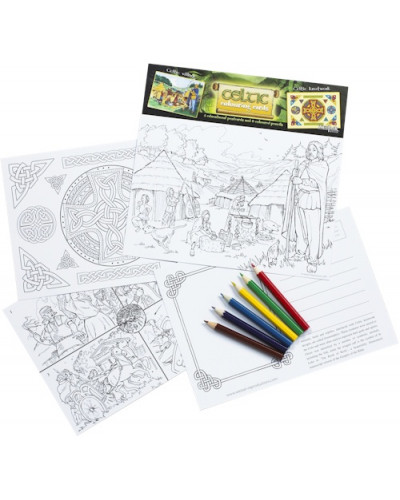Celtic Educational Colouring Postcards
- Product Code: CCC
- Availability: In Stock
- Pack Qty: 10
Product Description: The Celtic Colouring Postcards consists of four A5 size colouring cards and six colouring pencils. The cards include a single image of a Celtic Village scene, Celtic knotwork, Celtic zoomorphics, and a card depicting four images of the rise and fall of Boudicca. On the reverse of each card is an area to write a message, an address and to affix a stamp as well as educational information about the images on each card. There is a colourful header card that has pictures showing how the cards could be coloured in and all are held in a clear cellophane bag.
Information: The Celts were farmers who lived in isolated small villages, built close to sources of essential supplies. These included water, fish and animals for hunting, timber, meadowland for grazing livestock and copper and iron ore for smelting metals. Many were also skilled craftsman and metalworkers. Celtic roundhouses were usually made from wood. The walls were covered with daub, with thatch or reeds on the roof.
Originating from crafts such as weaving and basketry, knotwork designs were created and used by Celtic craftsmen on stone, manuscripts and metal jewellery. The interlocking designs represented eternal spiritual growth and the interlaced knotwork decorating the cross, was a popular Celtic pattern. Some of the finest examples of early Celtic knotwork can also be found in the illustrated manuscripts of ‘The Book of Kells’.
Animals, birds and reptiles, interlaced with Celtic knotwork designs, are called Zoomorphics. These creatures were sacred to the Celts and were often used to represent their gods and spirits. Christ was identified by a number of symbolic animals, including the fish, while the winged calf is the symbol of St Luke in ‘The Book of Kells’, a beautifully illuminated manuscript version of the Gospels of the Bible.
Boudicca was a Celtic warrior queen and leader of the Iceni tribe, which was persecuted by the Romans. Determined to fight back, Boudicca united the Celtic tribes against them. She led over 100,000 Celts into battle on her war chariot, burning the Roman towns of Camulodunum (Colchester), Verulamium (St Albans) and Londinium (London) to the ground. Finally defeated, Boudicca died on the battlefield, a true Celtic heroine.
Tags: Celtic, Educational, Colouring, Postcards

